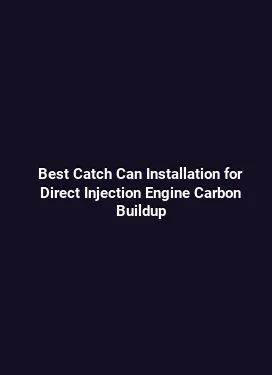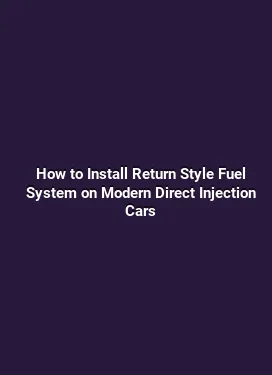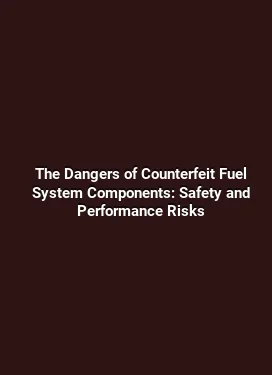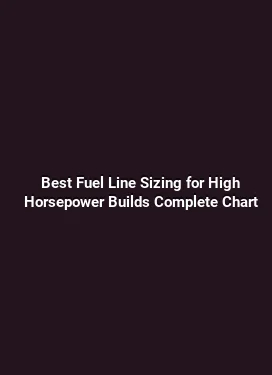The Truth About Throttle Body Spacers: Are They a Performance Upgrade or a Gimmick?
Understanding the Basics of Throttle Body Spacers

Throttle body spacers are aftermarket components designed to be installed between the throttle body and the intake manifold. Their primary claim is to improve air velocity, promote better fuel atomization, and, in some cases, increase torque or throttle response. At a glance, the idea seems straightforward: alter the path of incoming air to reduce turbulence, ultimately resulting in more efficient combustion. However, the actual impact on performance depends on several variables including engine size, displacement, cam profile, intake manifold design, and the broader state of the air-fuel system.
From a fluid dynamics perspective, the spacers introduce a small volume or plenum-like region that can modify the boundary layer and wave patterns traveling through the intake tract. In practice, several modern engines already feature sophisticated intake runners and throttle bodies that optimize air flow at a wide range of RPMs. For these setups, the marginal gains claimed by spacer manufacturers may be negligible or even negative if the spacer disrupts the carefully tuned air pulse. The reality is that benefits are highly context-specific and nowhere near universal.
How spacers influence air flow and plenum dynamics

Airflow behavior inside an intake system is governed by velocity, pressure waves, and turbulence. A spacer can create a small volume where pressure can equalize prior to air entering the plenum. In some configurations, this can smooth transient behavior during rapid throttle changes, potentially sharpening throttle response slightly. Yet, in other configurations, the added length and surface area can increase tachometer-friendly backpressure or create minor, localized flow separation. The net effect is a balance between smoother air pulses and potential impedance to peak high-RPM flow.
Another factor is the spacer’s geometry. A flat, uniform spacer may behave differently than a vane- or helix-pattern spacer. Some designs advertise swirl or tumble generation to promote better air-fuel mixing. While swirl can enhance mixing at certain operating points, the actual gains depend on the injector spray pattern, intake port shape, and the engine’s combustion chamber design. For engines with advanced direct injection or port fuel injection systems, the opportunity to leverage spacer-induced air swirl becomes even more nuanced and highly dependent on calibration.
Real-World Performance: Do spacers deliver measurable gains?
Measured outcomes vary widely. Anecdotal reports often cite improved throttle response and a small uptick in mid-range torque, yet controlled dynamometer testing frequently shows minimal or inconsistent power improvements. One of the core reasons for this inconsistency is the absence of a universal operating point where spacers shine. On naturally aspirated engines that already optimize intake resonance and plenum design, spacers tend to yield negligible horsepower gains. On forced-induction platforms or engines with intentionally tuned intake runners, the interaction becomes more complex and the spacer may disrupt the intended pulsating air wave that the tuner designed for peak efficiency.
From a fuel-system perspective, spacers do not change the fundamental fuel delivery; they alter the air path that the fuel encounters. If an engine tune is calibrated for a precise air mass at various RPMs, any change in air path can shift the air-fuel ratio slightly unless the ECU is retuned. In practical terms, if you are relying on a stock or lightly tuned engine, you may see little to no improvement. If you have a well-calibrated intake and an adjustable tuner, spacer-related changes could necessitate a retune to capture any potential benefits while avoiding lean or rich conditions that destabilize idle or driveability.
Comparing spacers to other intake enhancements
When evaluating performance upgrades, it is essential to consider spacers alongside other modifications. For example, aftermarket air intake systems, larger or smoother throttle bodies, and optimized intake plenum designs can have more pronounced effects, especially when combined with a calibrated engine management system. In many cases, a comprehensive approach—upgrading the intake track, ensuring clean air delivery, and pairing with a suitable calibration—yields a more substantial and reliable gain than a spacer alone.
The purity of air quality also matters. A spacer cannot compensate for poor air filtration, a dirty throttle body, or a clogged intake manifold. If the engine cannot draw in clean, unobstructed air, the potential benefits of any spacer are greatly diminished. In other words, the spacer is not a magic fix; it is a small, supplementary component whose value derives from the overall health and tuning of the intake and fuel systems.
Installation Considerations: Fitment, Materials, and Durability
Before choosing a spacer, evaluate fitment with your specific engine and intake manifold. Some spacers are designed for direct bolt-on compatibility with common throttle body modèles, while others require additional adapters or gaskets. The thickness of the spacer can influence throttle response and idle quality; thicker spacers may push the throttle plate away from its designed centerline, subtly affecting the throttle cable geometry and sensor readings. It is crucial to verify compatibility with your engine’s computer, manifold, and TPS (throttle position sensor) readings to ensure consistent operation.
Materials matter for thermal management and durability. Aluminum spacers typically provide good rigidity and heat dissipation, while composite spacers can save weight but may behave differently under high heat. Any spacer should include compatible gaskets and hardware rated for engine bay temperatures and vibration. Improper installation or torquing can lead to air leaks, vacuum leaks, or misalignment that undermines performance gains. A careful, clean installation with a fresh gasket surface is essential to prevent intake leaks that can cause lean conditions and misfires.
Tuning and calibration implications
Installing a spacer often necessitates a light calibration adjustment. Even a small shift in the air mass entering the engine can alter the air-fuel ratio and ignition timing. A conservative approach is to perform a monitored drive with data logging to check for any irregularities such as disconnected idle control, fluctuating idle RPM, or unexpected knock events. If your engine management system supports it, a targeted retune or a drivability check can help ensure that ignition timing and fueling remain stable across RPM bands after spacer installation.
For turbocharged or supercharged engines, the consequences may be amplified due to the tighter coupling between boost, airflow, and fueling. In such cases, a spacer should be evaluated in the context of a comprehensive boost control strategy and intercooling efficiency. Without this broader adjustment, the spacer’s effect can be masked by the more dominant force of forced induction.
Potential Drawbacks and When to Avoid a Throttle Body Spacer
There are scenarios where a spacer is unlikely to offer a meaningful return on investment. Engines with a tightly tuned intake manifold designed for peak efficiency at specific RPM ranges, or engines with electronically controlled throttle bodies that require precise sensor data, may experience little to no benefit. In some cases, spacers can introduce minor adverse effects such as increased intake plenum heat soak, slight delay in throttle response, or even vacuum leaks if the gasket seal is imperfect. For daily drivers or vehicles in regions with strict emissions testing, a spacer that affects air flow dynamics and fueling calibration could complicate compliance or diagnostic checks.
Weight considerations are another factor. While spacers are relatively light, any additional component in the intake tract adds unsprung mass and contributes to the overall package that the engine management system must account for. For performance builds where every gram matters, the marginal gains from spacers may not justify the potential risk of drivability issues or warranty concerns, especially on modern vehicles with complex emission and diagnostic systems.
When a spacer might be worth considering
In transitional engine builds—vehicles moving from stock to moderately upgraded intake components—a spacer can be part of a measured plan to explore airflow behavior. For example, in engines with custom intake runners or runners tuned for a specific resonance, a spacer can help to fine-tune the phase relationship of pressure waves. In some scenarios, a spacer may contribute to a small but noticeable improvement in mid-range torque, particularly when paired with a calibrated ECU tune that accounts for the altered air path. The key is to approach spacer installation as one element of a holistic approach to intake and fueling optimization rather than a standalone fix.
Understanding the Scope with Respect to Trend Keywords and LSI Concepts
In today’s performance discussions, customers often search for terms that reflect real-world behavior and practical outcomes. Concepts like air velocity, volumetric efficiency, and resonance tuning are part of a broader semantic cluster around intake efficiency. Discussions about throttle body spacers intersect with related ideas such as throttle response, air-fuel delivery dynamics, and the impact of air path length on engine behavior across RPM bands. Integrating these concepts helps align content with how enthusiasts think about performance, rather than presenting isolated, surface-level claims.
Latent Semantic Indexing (LSI) thinking shows up when content naturally covers related terms like mass air flow sensor feedback, intake manifold runner design, and fuel injector spray patterns. A well-rounded assessment of spacers acknowledges how these elements work together in a modern engine, rather than focusing solely on a single device. This holistic view is key to creating a credible, durable resource for readers who want to understand not just what a spacer does, but how it interacts with the entire intake and fuel system ecosystem.
Practical Recommendations for Enthusiasts
For readers considering a throttle body spacer, the following practical steps can help manage expectations and reduce risk:
- Assess your current intake design: If your engine already features a highly optimized intake manifold and a performance-tatched ECU, the incremental benefit of a spacer may be small.
- Check for compatibility: Ensure the spacer matches your throttle body size, gasket surfaces, and mounting hardware. Incompatibility can create leaks or misalignment.
- Plan a controlled test: If possible, perform a before-and-after evaluation on a dyno or through data logging to capture measurable changes rather than relying on seat-of-the-pants impressions.
- Factor in calibration: Be prepared to adjust fueling and ignition maps to account for altered intake dynamics after installation.
- Consider emissions and warranty: Verify that adding a spacer does not affect warranty terms or compliance with local emissions standards.
Ultimately, the spacer should be viewed as a supplementary modification. For many builds, the strongest gains come from improving the entire intake tract, ensuring clean air supply, and applying a thoughtful tune that leverages the engine’s natural resonance. A spacer can contribute modestly in the right context, but it is rarely the sole driver of a dramatic performance increase.
Case Study: A Balanced Upgrade Path
A practical example involves a naturally aspirated four-cylinder that already has a moderately free-flowing intake. After installing a spacer, the owner logs a small improvement in mid-range torque on the dyno, but peak horsepower remains largely unchanged. Subsequent retuning to align the air-fuel ratio with the changed air-path yields a smoother idle and a marginal but perceptible improvement in throttle response during city driving. This scenario illustrates how spacers can contribute within a broader upgrade plan, particularly when paired with a calibrated ECU and clean, high-velocity air delivery.
Maintenance and Longevity Considerations
Maintenance for spacers is minimal, but not negligible. Regular inspection for gasket integrity, especially after climate fluctuations or engine servicing, helps prevent leaks. If you remove the spacer for any reason, reseal the mounting surfaces and replace gaskets to maintain a proper seal upon reinstallation. In terms of long-term durability, spacers made from high-quality aluminum or composites with proper coatings should resist corrosion and heat cycling when properly installed and torqued to manufacturer specifications.
In summary, throttle body spacers occupy a nuanced niche within the broader intake and fuel system landscape. They are not a universal performance magic wand, but when integrated with a thoughtful upgrade strategy that includes air filtration, intake tract optimization, and a tuned fuel strategy, they can offer small but meaningful improvements in specific scenarios. For most street-driven vehicles with stock-to-mildly modified configurations, it is wise to approach spacers with measured expectations and an emphasis on holistic intake system optimization rather than a stand-alone upgrade.






